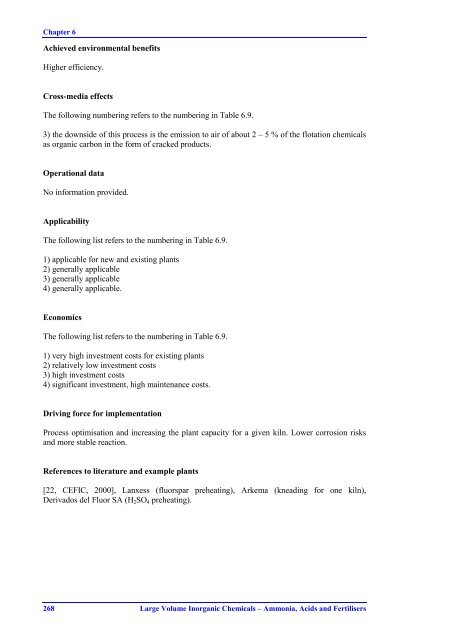Large Volume Inorganic Chemicals - Ammonia ... - ammk-rks.net
Large Volume Inorganic Chemicals - Ammonia ... - ammk-rks.net Large Volume Inorganic Chemicals - Ammonia ... - ammk-rks.net
Chapter 6Achieved environmental benefitsHigher efficiency.Cross-media effectsThe following numbering refers to the numbering in Table 6.9.3) the downside of this process is the emission to air of about 2 – 5 % of the flotation chemicalsas organic carbon in the form of cracked products.Operational dataNo information provided.ApplicabilityThe following list refers to the numbering in Table 6.9.1) applicable for new and existing plants2) generally applicable3) generally applicable4) generally applicable.EconomicsThe following list refers to the numbering in Table 6.9.1) very high investment costs for existing plants2) relatively low investment costs3) high investment costs4) significant investment, high maintenance costs.Driving force for implementationProcess optimisation and increasing the plant capacity for a given kiln. Lower corrosion risksand more stable reaction.References to literature and example plants[22, CEFIC, 2000], Lanxess (fluorspar preheating), Arkema (kneading for one kiln),Derivados del Fluor SA (H 2 SO 4 preheating).268 Large Volume Inorganic Chemicals – Ammonia, Acids and Fertilisers
Chapter 66.4.2 Energy recovery from kiln heatingDescriptionThe kiln shell exit gas temperature goes up to about 400 °C, depending on the HF productionrate (expressed as tonne HF/m 2 of kiln shell surface area). Several heat recovery systemsremove the excess heat to reduce the gas temperature down to 200 / 250 °C. This recovered heatis either used to preheat reactant feeds, the combustion air, or by other fluids in the productionunit.Achieved environmental benefitsEnergy savings. The recovered energy for the whole installation is estimated to be around 20 %of the total energy used.Cross-media effectsNone believed likely.Operational dataNo information provided.ApplicabilityGenerally applicable for new installations.The installation of a recovery system for an existing plant might encounter technical limitationsin specific cases. When it is possible to install a recovery system, the associated cost andmodifications are usually disproportionate compared with the actual energy savings.EconomicsNo specific information provided.Driving force for implementationEnergy and cost savings.References to literature and example plants[22, CEFIC, 2000]Large Volume Inorganic Chemicals – Ammonia, Acids and Fertilisers 269
- Page 246 and 247: Chapter 5OriginChinaMine/regionRare
- Page 248 and 249: Chapter 55.2.2.2 GrindingDepending
- Page 250 and 251: Chapter 55.3 Current emission and c
- Page 252 and 253: Chapter 5Emission of mg/l g/tonne P
- Page 254 and 255: Chapter 55.4 Techniques to consider
- Page 256 and 257: Chapter 55.4.2 Hemihydrate process
- Page 258 and 259: Chapter 55.4.3 Hemi-dihydrate recry
- Page 260 and 261: Chapter 55.4.4 Hemi-dihydrate recry
- Page 262 and 263: Chapter 55.4.5 Di-hemihydrate recry
- Page 264 and 265: Chapter 55.4.6 RepulpingDescription
- Page 266 and 267: Chapter 55.4.7 Fluoride recovery an
- Page 268 and 269: Chapter 55.4.8 Recovery and abateme
- Page 270 and 271: Chapter 5Operational dataNo informa
- Page 272 and 273: Chapter 55.4.11 Decadmation of H 3
- Page 274 and 275: Chapter 55.4.12 Use of entrainment
- Page 276 and 277: Chapter 5Cross-media effects• dis
- Page 278 and 279: Chapter 5Driving force for implemen
- Page 280 and 281: Chapter 5Cross-media effectsTable 5
- Page 282 and 283: Chapter 5ApplicabilityAt present, o
- Page 285 and 286: Chapter 66 HYDROFLUORIC ACID6.1 Gen
- Page 287 and 288: Chapter 6Component Portion (mass co
- Page 289 and 290: Chapter 66.2.4 Process gas treatmen
- Page 291 and 292: Chapter 66.3 Current emission and c
- Page 293 and 294: Chapter 6Emission of kg/tonne HF Re
- Page 295: 6.4 Techniques to consider in the d
- Page 299 and 300: Chapter 66.4.4 Valorisation of fluo
- Page 301 and 302: Chapter 66.4.6 Scrubbing of tail ga
- Page 303 and 304: 6.4.7 Scrubbing of tail gases: fluo
- Page 305 and 306: Chapter 66.4.8 Abatement of dust em
- Page 307 and 308: Chapter 66.4.9 Waste water treatmen
- Page 309 and 310: Chapter 6Cross-media effects• 5 -
- Page 311 and 312: Chapter 77 NPK AND CN7.1 General in
- Page 313 and 314: Chapter 77.2 Applied processes and
- Page 315 and 316: Chapter 77.2.3 Direct neutralisatio
- Page 317 and 318: Chapter 7Fluorine compounds origina
- Page 319 and 320: Chapter7Per tonne productkWh Nm 3 k
- Page 321 and 322: Chapter7Emission levelmg/Nm 3 ppm k
- Page 323 and 324: Chapter7Emission levelmg/Nm 3 ppm k
- Page 325 and 326: 7.4 Techniques to consider in the d
- Page 327 and 328: Chapter7Driving force for implement
- Page 329 and 330: Chapter7Driving force for implement
- Page 331 and 332: Chapter7Driving force for implement
- Page 333 and 334: Chapter7Achieved environmental bene
- Page 335 and 336: Chapter77.4.6 Recycling warm airDes
- Page 337 and 338: Chapter77.4.7 Optimising the recycl
- Page 339 and 340: Chapter7Operational dataThe volume
- Page 341 and 342: Chapter7Achieved environmental bene
- Page 343 and 344: Chapter7Achieved environmental bene
- Page 345 and 346: Chapter77.4.11 Recycling of scrubbi
Chapter 6Achieved environmental benefitsHigher efficiency.Cross-media effectsThe following numbering refers to the numbering in Table 6.9.3) the downside of this process is the emission to air of about 2 – 5 % of the flotation chemicalsas organic carbon in the form of cracked products.Operational dataNo information provided.ApplicabilityThe following list refers to the numbering in Table 6.9.1) applicable for new and existing plants2) generally applicable3) generally applicable4) generally applicable.EconomicsThe following list refers to the numbering in Table 6.9.1) very high investment costs for existing plants2) relatively low investment costs3) high investment costs4) significant investment, high maintenance costs.Driving force for implementationProcess optimisation and increasing the plant capacity for a given kiln. Lower corrosion risksand more stable reaction.References to literature and example plants[22, CEFIC, 2000], Lanxess (fluorspar preheating), Arkema (kneading for one kiln),Derivados del Fluor SA (H 2 SO 4 preheating).268 <strong>Large</strong> <strong>Volume</strong> <strong>Inorganic</strong> <strong>Chemicals</strong> – <strong>Ammonia</strong>, Acids and Fertilisers



